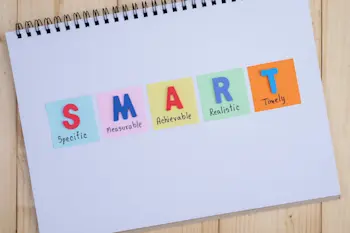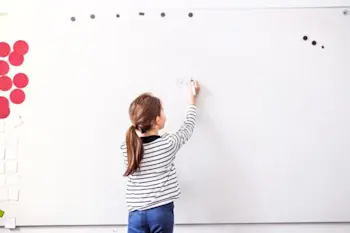How do I help set goals for my child this school year?
Learn how to set effective SMART goals for your child's school year. Maximise academic potential with Explore Learning's expert guidance.

Support your child in creating a set of effective goals that will boost their confidence, motivation and achievements for the school year ahead.
Read on to find our suggestions for setting goals for your child this school year.
What is a goal?
When you hear the word goal do you automatically think of your to-do list?
If you do, you’ve gone a little too far. Take a step back. The goal is the bigger picture, it’s the ‘why’ behind all our actions. The goal for this to-do list might be ‘I want to be healthy’ and these are all actions that will help to achieve that goal.
Having a goal can drive and sustain motivation. It can help us achieve what we want in life!
Number one rule for setting goals for your child
For your children, goal setting can be a hugely empowering life skill. Yet it’s a step that can easily be missed. We might make the mistake of starting our own list like this:
Goals for my child this school year 1. Learn 4 times tables 2. Complete orange level books 3. Get 8/10 in weekly spellings
However, the first rule in goal setting is you can only make goals for yourself. Goals that someone else sets for you are almost inevitably going to fail because you didn’t choose them. However, as a parent, you can help your child reach their goals by teaching your child how to set goals and supporting them to make them happen.
Examples of goals for children

Goal setting does not need to be a term used exclusively in the workplace or in a sports team. It has a lot of value at home and in a child’s learning. Anything that your child really wants to achieve, or a challenge they want to overcome, can be a goal.
Here are some examples of wishes your child may have:
I want to be in the school production.
I want to learn how to ride a bike.
I want to learn a new magic trick.
I want to build a den in the garden.
I want to learn my 12 times tables.
I want to finish reading the Harry Potter series.
SMART goals
You may have heard of the acronym SMART. It’s really useful to think about when it comes to your child’s goals. It stands for specific, measurable, achievable, relevant and timely:

If your goal can tick all of those boxes then you’re more likely to achieve it. So let’s turn the wishes into SMART goals.
I will be in the school production this July.
I will learn how to ride a bike by the end of the summer holidays.
I will learn a new magic trick to perform at the party next Saturday.
I will build a den in the garden by the end of April.
I will learn my 12 times tables by the end of the month.
I will finish reading the Harry Potter series before my Birthday.
When you create a SMART goal you should be able to answer to following questions:
Specific- What do you want to be/do/have?
Measured- How will you know that you’ve accomplished this?
Achievable- If you really put in the effort and focus your energies, is this something you can believe can achieve by the deadline?
Relevant- Will achieving this help you in some meaningful way in your life?
Timely- When do you want to achieve this?
Why is goal setting important for children?
Goal setting is a critical life skill that enables children to:
Develop stamina and resilience when the going gets tough
Sustain a positive attitude
Take responsibility – for their learning and general behaviour
Manage distractions
Reduce procrastination
Prioritise effectively
These might sound like high, maybe unrealistic, expectations for a young child or a teenager. They don’t have to be. With the right goal and the right approach, you could see your child developing their abilities in all of these areas.

Educational goals for children
In education, we know that when students see a purpose for what they’re learning, they perform better.
In order to help your child set an educational goal it’s a good idea to start with some big questions.
What might happen if you do well in class this year?
Why does school matter?
What do you want to do in the future?
How can the things you do at school help you in life?
How will you feel when you achieve those goals?
How will it help other people?
If your child can find a greater purpose behind their academic goals, you’re likely to see greater results from their goal-setting. Especially when the purpose is helpful to others as well as themselves.
Goals can be specific to a subject but you might also like to think about learning habits. At Explore Learning, we have found that children can achieve great success when we focus on a habit that will benefit them across all their subjects.
A learning habit might be:
Asking for help when you need it
Not being afraid to make mistakes
Taking your time to work out a problem
Staying engaged
Completing a number of activities before taking a break
What learning habits might help your child make a big academic change?
Top 3 goals for children
Once you get started with goal setting it can be tempting to come up with a lot! However, a small number is best. Go for your top three. This way you can all keep track of how things are going.
Remember to make it SMART so that there is a time not too far ahead when the goal can be achieved. Then you can celebrate your child when they achieve it and identify a new one.

How to help your child set goals
Help your child to set goals by following these six steps:
Ask your child the big questions
Establish the purpose and link it to the greater good
Come up with ideas that will help achieve that goal
Break the goal into smaller steps
Create a visual plan
Plan how to deal with setbacks
Asking questions
Try a conversation along these lines…
Parent: What do you want to do in the future?
Zoe: I really want to work with animals.
Parent: You’d be great at that. Do you know what things you’re doing at school that can help you with that?
Zoe: Maybe science and maths.
Parent: Yes they would be important if you wanted to become a vet or even just helping as a zookeeper with feed and medicines. Do you think there’s anything else?
Zoe: Not sure.
Parent: I’m thinking English is important too because you’d probably need to do some research and read a lot about what different animals need. Shall we think about what things you can do at school and at home to help with this goal?
Establishing your child’s purpose (and linking it to the greater good)
By asking questions you can establish your child’s purpose. In the example above, Zoe’s big goal is to help animals. This is a purpose that doesn’t just benefit her but has a greater social benefit.
Studies have found that students are more successful when they understand that their goal can also benefit others. Isn’t that wonderful?
In other words, you’re more likely to stick at the boring, unpleasant tasks if your end goal helps you and others.
Whatever your child is driven by, I am confident that you’ll be able to find a way to link it with helping others, and in doing so, you’ve increased your child’s chances at succeeding in their life goals.
Goal- I want to make great video games
How it benefits others- To entertain and challenge people
Goal- I want to invent something amazing
How it benefits others- It will make people’s lives easier
Goal- I want to be a really good footballer
How it benefits others- It will make my community proud.
Coming up with ideas
You can now discuss what might help them get there. Talk about the things they can do at school and those at home that will get them closer to their big goal.
Write the big, long term goal on the centre of a big piece of paper and surround it with all the things you could do to get closer to the goal on post-it notes so you can move things around.
Let your child choose a couple of the ideas to take forward but keep this paper as inspiration to return to in the future.
Breaking the goal into smaller steps
So, maybe your child says they want to do better in maths. As a parent, you can teach children to break this goal down into smaller steps and set a goal that is SMART.
Discuss the things that they would like to improve on. What does doing better actually look like? When do they want to see change? You might end up with a statement like this:
“I want to score full marks in my arithmetic test next month.”

Creating a visual plan
Now encourage your child to write it down on paper and list the actions that they are going to take to make it happen.
Visualising is a really important part of goal setting. Did you know when you write goals down, you are 42% more likely to achieve them?
Tracking progress
It’s important to know whether you’re making good progress or not. You might decide to keep a record of how many questions you answer each day and how many of them are correct. You might use a calendar to mark off how many days of practise have been completed.
Motivation
Always remind your child of their bigger purpose. Go back to the big goal conversation.
“You want to score full marks in your arithmetic test next month so you can be better at maths and look after animals in the future.”
However, big goals are way off in the future so it’s important to agree some small rewards to support your child along the way. Ask how they want to reward themselves when they practise their maths each day. It should be something small and realistic – you might be surprised what they come up with.
Your child deciding the reward is just as important as selecting the goal. This is an important step to achieving self-motivation.
Dealing with setbacks
There will always be obstacles in the way of you achieving your goal. It’s important not to ignore this. Now you’ve got a plan, discuss what might go wrong.
The most common set back for all goals is our human tendency to give up. So ask your child the question, what will you do if you feel like giving up? The answer might be to talk to you, try something else for an hour and come back to it, take the dog for a walk. Write this down on the visual plan too as a reminder that you might need some extra drive to get you there some days.
Rewarding and celebrating success
When your first goal is achieved it’s really important to mark and recognise the success in getting there. Praise the effort that your child put in, how they handled setbacks and the moments they showed resilience. Once a child feels the success of achieving a goal that they set themselves, they will feel on top of the world and ready for making the next big step towards their dreams.

Techniques for staying on track
You’ve both worked so hard and come up with the perfect SMART goal but motivation has slipped and the practices your child committed to are slipping away.
Try these top tips
Talk about someone your child really admires – it could be someone famous or family or friend. How did they get where they are today? What do you think they do when something gets tough?
Read some inspirational books or stories of children like them.
Remember the original purpose. Do some more research about their goal, put up some pictures of inspiration.
Recognise and celebrate the steps that your child’s taken so far. Focus on the improvements that they’ve made.
Do they need a different form of motivation? Discuss if there are any changes that need making to the plan.
Help them to visualise how they are going to feel when they achieve this goal.
Are you ready to get started?
Make some time for you and your child to discuss goals this week. If you would like more help with goal setting or feel that your child may benefit from additional tuition in maths and English to help with their educational goals, then our dedicated tutors at Explore Learning are here to help.
Cancel anytime
No joining fee
In centre or online
Memberships to suit you
Cancel anytime
No joining fee
In centre or online
Memberships to suit you
Cancel anytime
No joining fee
In centre or online
Memberships to suit you




